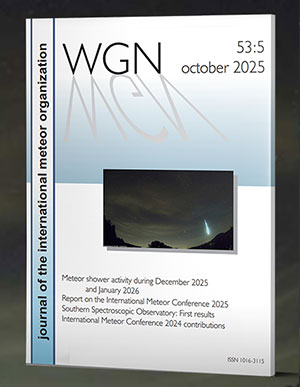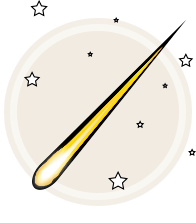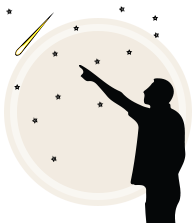This minor shower is known to having produced short-lived activity
peaks with ZHRs of the order of 30 to 40. Since this shower has not
been monitored regularly until very recently, other outbursts may
have been missed. In 2000 the conditions were good (almost New Moon).
According to observations in previous years, the peak period was
expected near 18h UT (lambda = 158.6°) on August 31, 2000. Within
the monitored intervals no unusual activity was reported, but there
is still a gap in the available data between 158.0 and 158.7°
(i.e. Aug 31, 3h UT and Aug 31, 20h UT). The highest rates occurred
in the first period centered at 158.77°, but care must be taken
because these ZHRs were obtained from European sites when the radiant
elevation was around or even below 20° and are thus uncertain.
Intervals with the radiant being less than 15° above the horizon
were not considered in the averages. However, there are no signs for
unusual rates in these periods as well. Furthermore, video recordings
and forward scatter data (Radio Observation Meteor Bulletin No. 85)
also indicate a rather low activity of the alpha Aurigids in 2000.
------------------------------------------------------ Date Time (UT) Sollong nObs nIND nAUR ZHR +/- ------------------------------------------------------ Aug 29 0120 156.024 2 2 1 2.6 1.8 31 0150 157.967 1 1 3 7.8 3.9 31 2130 158.770 3 2 7 10.4 3.7 31 2240 158.813 8 5 17 6.4 1.5 Sep 01 0030 158.884 7 5 12 3.1 0.9 01 0830 159.201 1 1 1 1.0 0.7 01 2330 159.781 10 6 21 3.3 0.7 ------------------------------------------------------
Solar longitudes refer to equinox J2000.0. nObs is the number
of individual observing periods, nIND is the number of individual
observers providing them, nAUR is the number of Aurigids seen.
The population index used was r=2.5. The expectation value of the
ZHR,
ZHR = (1 + sum nAUR) / sum(Teff/C),
was used for the averages here, where Teff is the effective
observing time and C is the total correction composed of limiting
magnitude, clouds, and zenith correction. Times are rounded to
the nearest 10 minutes.
We are very grateful to the following 15 observers who sent in their
reports in time for this first activity overview:
ATAJU Jure Atanackov (Slovenia),
BUCAN Andreas Buchmann (Switzerland),
COOMA Mary Cook (UK),
DUBAU Audrius Dubietis (Lithuania),
ENZFR Frank Enzlein (Germany),
GEOPE Petros Georgopoulos (Greece),
GODSH Shelagh Godwin (UK),
JOHCA Carl Johannink (Germany),
KACJA Javor Kac (Slovenia),
LINMI Mike Linnolt (USA),
MCBAL Alastair McBeath (UK),
MCLNO Norman McLeod (USA),
RENJU Jurgen Rendtel (Germany),
WUSOL Oliver Wusk (Germany) and
ZAKJU Jure Zakrajsek (Slovenia).



 You saw something bright and fast? Like a huge shooting star? Report it: it may be a fireball.
You saw something bright and fast? Like a huge shooting star? Report it: it may be a fireball.  You counted meteors last night? Share your results with us!
You counted meteors last night? Share your results with us!  You took a photo of a meteor or fireball? You have a screenshot of your cam? Share it with us!
You took a photo of a meteor or fireball? You have a screenshot of your cam? Share it with us!  You caught a meteor or fireball on video? Share your video with us!
You caught a meteor or fireball on video? Share your video with us!